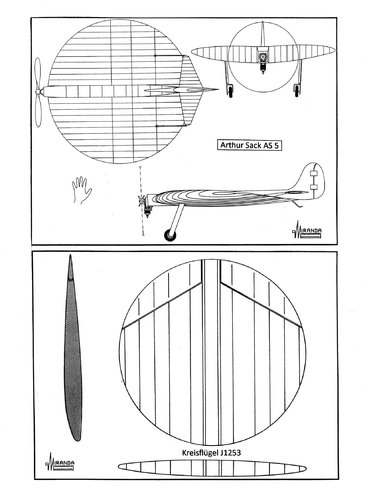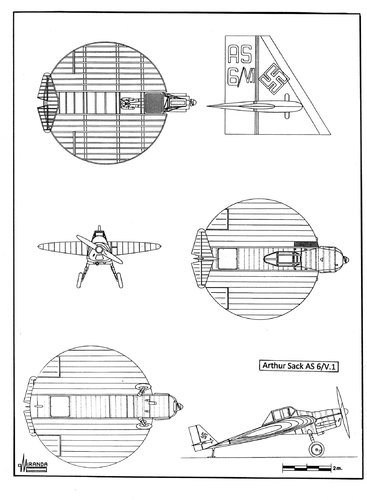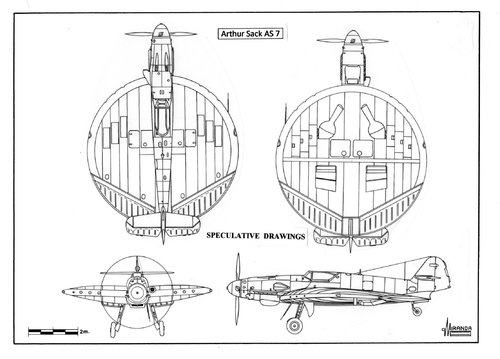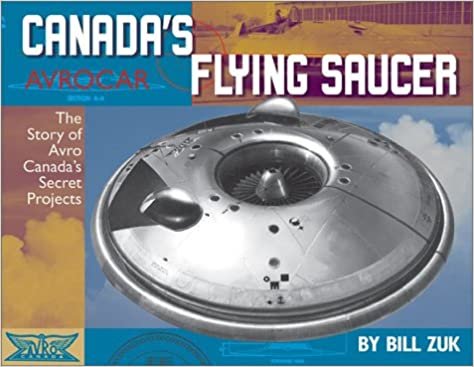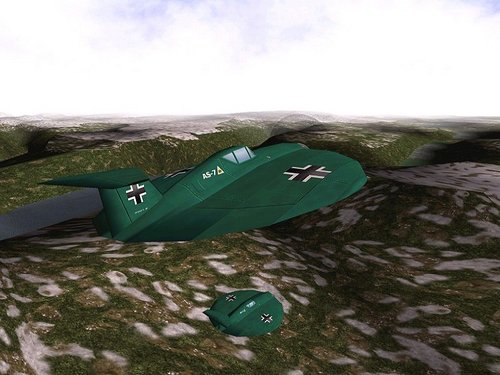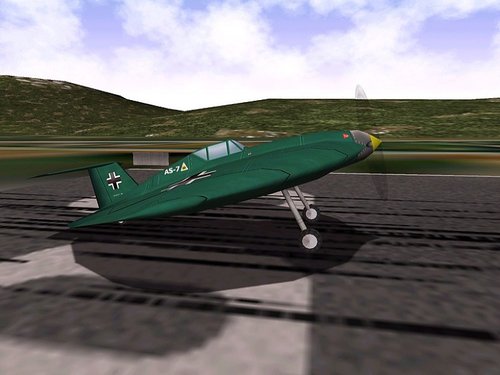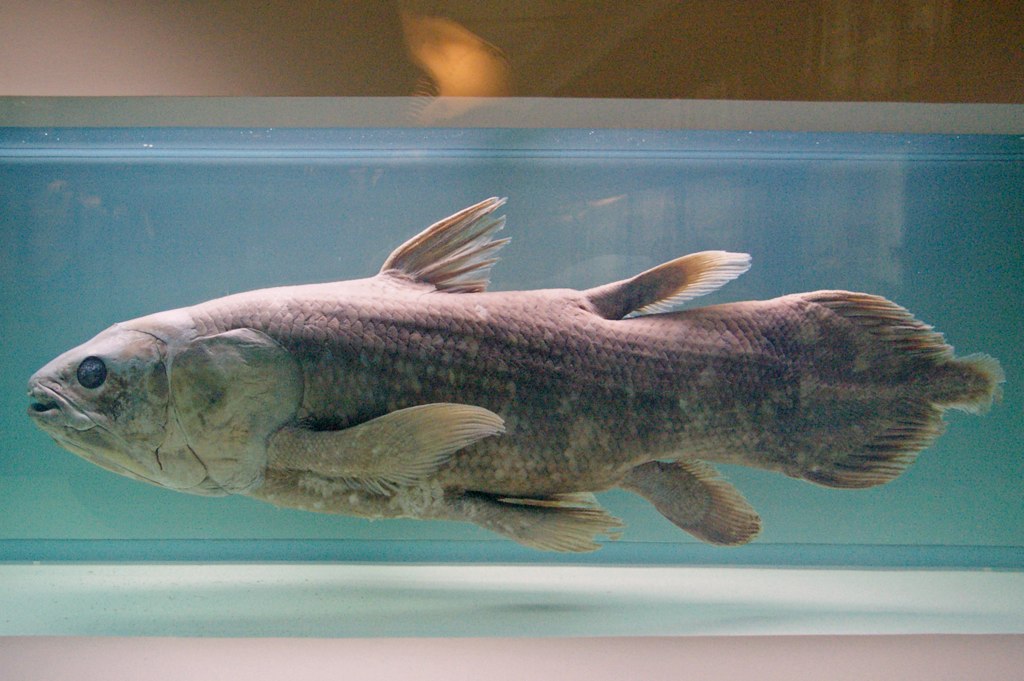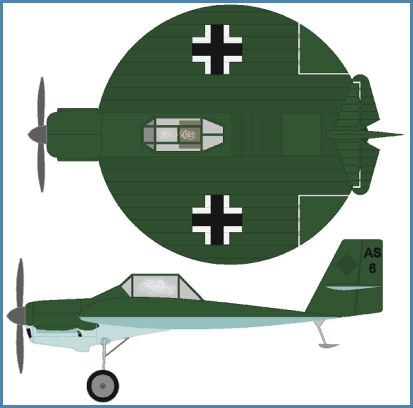You are using an out of date browser. It may not display this or other websites correctly.
You should upgrade or use an alternative browser.
You should upgrade or use an alternative browser.
Arthur Sack circular wing "flying saucers"
- Thread starter Justo Miranda
- Start date
"Flying Saucer Technology" by Bill Rose, Midland, 2011.
windswords
ACCESS: Secret
- Joined
- 19 May 2009
- Messages
- 389
- Reaction score
- 217
Circular wings IMO are not flying saucers anymore than the Me-163 is a flying wing. They are almost but not quite. Your mileage may very.
- Joined
- 11 March 2012
- Messages
- 3,249
- Reaction score
- 3,178
Agreed dear windswords,
Definitions of "flying wings" vary widely.
We can probably start by agreeing that any airplane without a horizontal stabilizer: tail or canard counts as a flying wing.
Purists will tell you that only nurflugel (only wing) counts as a pure flying wing. Even the Horten brothers deed to cheat by adding cockpits and cargo pods that extended outside of the minimum wing structure.
Northrop's 1940s vintage flying wing bombers were close to your definition, but still had vertical stabilizers.
What about all those small, competition sailplanes: Fauvel, Marske, BKB, etc. that still needed rudders and large cockpit nacelles. Marske used forward-swept wings, but the basic balance issues are the same.
Messerschmitt 163 is a swept wing with a massive vertical fin and fuselage, but no horizontal tail surfaces. I count Me-162 as a flying wing.
Similarly, most delta wings are also flying wings.
"Flying saucers" are VTOLs more often associated with Nazis living in the Antarctic or alien visitors from other planets. Only AVRO of Canada flew a few "flying saucers" but they proved hopelessly unstable with 1950s control technology.
The only true flying wings currently in service are the Northrup B-2 bomber and a few stealthy drones, but even they need extended centre sections to hide crew, bombs, sensors, etc.
Definitions of "flying wings" vary widely.
We can probably start by agreeing that any airplane without a horizontal stabilizer: tail or canard counts as a flying wing.
Purists will tell you that only nurflugel (only wing) counts as a pure flying wing. Even the Horten brothers deed to cheat by adding cockpits and cargo pods that extended outside of the minimum wing structure.
Northrop's 1940s vintage flying wing bombers were close to your definition, but still had vertical stabilizers.
What about all those small, competition sailplanes: Fauvel, Marske, BKB, etc. that still needed rudders and large cockpit nacelles. Marske used forward-swept wings, but the basic balance issues are the same.
Messerschmitt 163 is a swept wing with a massive vertical fin and fuselage, but no horizontal tail surfaces. I count Me-162 as a flying wing.
Similarly, most delta wings are also flying wings.
"Flying saucers" are VTOLs more often associated with Nazis living in the Antarctic or alien visitors from other planets. Only AVRO of Canada flew a few "flying saucers" but they proved hopelessly unstable with 1950s control technology.
The only true flying wings currently in service are the Northrup B-2 bomber and a few stealthy drones, but even they need extended centre sections to hide crew, bombs, sensors, etc.
OK , Arthur Sack circular wing "flying saucers" 
The myth continues. The Avrocar was designed to fail. To show the Russians we had no idea about how to get such a craft off the ground. Then Flying Saucer Aircraft by Bill Rose appeared. The Avrocar had the designation Weapons System 606A. There was also Weapons System 606A (Supersonic Application) which was a different design. Other designs included Avro Canada's PV.704 (PV for Private Venture). It also references the work of Nathan Price at Lockheed. A patent was filed on 1-23-1953 for a High velocity, high altitude, V.T.O.L. aircraft, patent US3103324A. It was a circular aircraft.
blackkite
Don't laugh, don't cry, don't even curse, but.....
- Joined
- 31 May 2007
- Messages
- 8,819
- Reaction score
- 7,716
Last edited:
blackkite
Don't laugh, don't cry, don't even curse, but.....
- Joined
- 31 May 2007
- Messages
- 8,819
- Reaction score
- 7,716
Hi! AS-7 RC model.
It seems that it is hard to stall even if the angle of attack is large.
View: https://www.youtube.com/watch?v=asbS3lJHBf8
It seems that it is hard to stall even if the angle of attack is large.
Last edited:
Grzesio
ACCESS: Secret
It's hard too tell, flying models like this can have very high power-to-weight ratio, allowing them to virtually "hang" on the propeller.It seems that it is hard to stall even if the angle of attack is large.
blackkite
Don't laugh, don't cry, don't even curse, but.....
- Joined
- 31 May 2007
- Messages
- 8,819
- Reaction score
- 7,716
Hi!
http://discaircraft.greyfalcon.us/ARTHUR SACK A.htm
"Arthur Sack was a farmer who enjoyed constructing aero-models.
In June 1939 in Leipzig-Mockau he attended the First National Contest of Aero-models with Combustion Engines, where he hand-launched his first aero model with a circular wing, the AS-1. It possessed rather poor flying qualities. Arthur Sack's aeromodel measured 125 cm and weighed just 4.5 kg, powered by a Kratmo-30 motor of 0.65 V and 4,500 RPM with a propeller measuring 600 mm in diameter. His circular aircraft was unable to lift off the ground by itself, and finally Sack had to throw it into the air in desperation. After this assisted takeoff , the model managed to perform 100 meters of stable flight, just barely reaching the finish line.
However, the odd-shaped model instantly caught the attention of Air Minister General Udet who was fascinated by the circular shape and gave Sack permission to proceed with his research with official backing. Sack immediately began construction of A.S. aero models of increasing size up to the A.S.5 which was by far the largest flying model. With a wingspan of 125 cm, length of 159 cm, and height of 65.3 cm the two-bladed propeller model took to the air and proved the soundness of the basic design."
http://discaircraft.greyfalcon.us/ARTHUR SACK A.htm
"Arthur Sack was a farmer who enjoyed constructing aero-models.
In June 1939 in Leipzig-Mockau he attended the First National Contest of Aero-models with Combustion Engines, where he hand-launched his first aero model with a circular wing, the AS-1. It possessed rather poor flying qualities. Arthur Sack's aeromodel measured 125 cm and weighed just 4.5 kg, powered by a Kratmo-30 motor of 0.65 V and 4,500 RPM with a propeller measuring 600 mm in diameter. His circular aircraft was unable to lift off the ground by itself, and finally Sack had to throw it into the air in desperation. After this assisted takeoff , the model managed to perform 100 meters of stable flight, just barely reaching the finish line.
However, the odd-shaped model instantly caught the attention of Air Minister General Udet who was fascinated by the circular shape and gave Sack permission to proceed with his research with official backing. Sack immediately began construction of A.S. aero models of increasing size up to the A.S.5 which was by far the largest flying model. With a wingspan of 125 cm, length of 159 cm, and height of 65.3 cm the two-bladed propeller model took to the air and proved the soundness of the basic design."
Last edited:
blackkite
Don't laugh, don't cry, don't even curse, but.....
- Joined
- 31 May 2007
- Messages
- 8,819
- Reaction score
- 7,716
"From this point on Sack was determined to build a manned machine that would become the Arthur Sack A.S.6V-1.
The aircraft was built in Leipzig starting in January 1944 in the workshops of the Mitteldeutsche Motorwerke company. Assembly and final tuning were performed at the Flugplatz-Werkstatt workshop at Brandis air base during the same month.
The basic structure was made of plywood while the cockpit, pilot seat, and landing gear all came from an old wrecked Me Bf 109B. The engine was taken from a Me Bf 108 Taifun, an Argus As 10C-3 of 240 hp working on an old wooden two-blade propeller.
In February 1944, the A.S.6V-1 taxi test started, piloted by Baltabol from the ATG/DFW of Leipzig. The first test proved that the rudder was not strong enough and some structural damage resulted from the test.
During the second test five separate take-off runs were attempted from the 1,200 meter landing strip at Brandis. It was soon discovered that the control surfaces failed to function properly because they were positioned in the vacuum area produced by the circular wing while taxiing. The right leg of the landing gear was damaged on the last run.
Due to war restrictions more powerful engines than the low-hp Argus were not available so the incidence angle was increased. The test pilot at this point proposed moving the landing gear back 20 cm, but due to structural reasons that could not be overcome, the modification was deemed too risky. Instead, brakes were installed from a Ju-88, 70 kg of ballast was added ahead of wing spar No.3 and the tail surfaces were increased by adding 20mm of corrugated plates.
The third test flight was performed over the 700 meter strip at Brandis on April 16, 1944. There was no wind and the plane rolled 500 meters without lifting its tail. No aerodynamic control of the empennages was achieved. The plane made a brief hop but could not get into the air.
During the fourth flight test the jump was a bit longer; however, the plane banked to the left because of torsion generated by the propeller, this being very difficult to balance in a small wingspan aircraft.
After this Baltabol lost all hope and recommended the installation of a proper Daimler-Benz engine from a current Me Bf 109 and a complete study of the basic design in an aerodynamic wind tunnel. Sack went on trying to solve the problem by himself in the traditional manner until the end of the war. "
The aircraft was built in Leipzig starting in January 1944 in the workshops of the Mitteldeutsche Motorwerke company. Assembly and final tuning were performed at the Flugplatz-Werkstatt workshop at Brandis air base during the same month.
The basic structure was made of plywood while the cockpit, pilot seat, and landing gear all came from an old wrecked Me Bf 109B. The engine was taken from a Me Bf 108 Taifun, an Argus As 10C-3 of 240 hp working on an old wooden two-blade propeller.
In February 1944, the A.S.6V-1 taxi test started, piloted by Baltabol from the ATG/DFW of Leipzig. The first test proved that the rudder was not strong enough and some structural damage resulted from the test.
During the second test five separate take-off runs were attempted from the 1,200 meter landing strip at Brandis. It was soon discovered that the control surfaces failed to function properly because they were positioned in the vacuum area produced by the circular wing while taxiing. The right leg of the landing gear was damaged on the last run.
Due to war restrictions more powerful engines than the low-hp Argus were not available so the incidence angle was increased. The test pilot at this point proposed moving the landing gear back 20 cm, but due to structural reasons that could not be overcome, the modification was deemed too risky. Instead, brakes were installed from a Ju-88, 70 kg of ballast was added ahead of wing spar No.3 and the tail surfaces were increased by adding 20mm of corrugated plates.
The third test flight was performed over the 700 meter strip at Brandis on April 16, 1944. There was no wind and the plane rolled 500 meters without lifting its tail. No aerodynamic control of the empennages was achieved. The plane made a brief hop but could not get into the air.
During the fourth flight test the jump was a bit longer; however, the plane banked to the left because of torsion generated by the propeller, this being very difficult to balance in a small wingspan aircraft.
After this Baltabol lost all hope and recommended the installation of a proper Daimler-Benz engine from a current Me Bf 109 and a complete study of the basic design in an aerodynamic wind tunnel. Sack went on trying to solve the problem by himself in the traditional manner until the end of the war. "
blackkite
Don't laugh, don't cry, don't even curse, but.....
- Joined
- 31 May 2007
- Messages
- 8,819
- Reaction score
- 7,716
"The A.S.6V-1 would have sat for the duration had it not been for the arrival of Gruppe I/JG400 at Brandis in the summer of 1944. These were the confident new Me-163 Komet pilots who had plenty of experience with difficult take-offs and landings with short wingspan aircraft. So, it was inevitable that one of them, Oberleutnant Franz Roszle, made an attempt to fly what the Gruppe named the "Bierdeckel" (Beer tray)!
His attempt, like Baltabol before him, ended with a short hop and collapsed landing gear. The Komet pilot made the same suggestion to Sack about testing the design in a wind tunnel and then turning the aircraft over to Messerschmitt for proper redesign with components of the latest Me Bf 109 fighter, including armaments. Sack refused to listen or ask any favors from the RLM. Messerschmitt got word of the A.S.6V-1 and actually proposed that a new A.S.7V-1 should be re-designated as Me-600.
The proposed Me-600 would have enlarged the circular wing considerably and featured a complete fuselage with the latest DB 605 ASCM/DCM of 2,000 hp with MW injection and a four-bladed propeller, repositioned gear, improved control surfaces, redesigned tail unit, Galland hood, and six MK-108 cannon buried in the reinforced circular wing! With wind tunnel data corrections and Messerschmitt construction the projected Me-600 would have been a formidable 500 mph fighter.
The odd circular wing already had the Komet pilots making suggestions for a new nickname. They would call any Sack aircraft that made it into combat the "Bussard" (Buzzard)! The name was proposed by the nature of the A.S.6V-1 which didn't fly much but spent a lot of time on the ground and made out of "scavenged" parts!
But Sack never got the chance to fix the A.S.6V-1 as it was strafed one day and then cut up and dismantled before US
troops arrived at Brandis in April 1945. They found no trace of the aircraft."
His attempt, like Baltabol before him, ended with a short hop and collapsed landing gear. The Komet pilot made the same suggestion to Sack about testing the design in a wind tunnel and then turning the aircraft over to Messerschmitt for proper redesign with components of the latest Me Bf 109 fighter, including armaments. Sack refused to listen or ask any favors from the RLM. Messerschmitt got word of the A.S.6V-1 and actually proposed that a new A.S.7V-1 should be re-designated as Me-600.
The proposed Me-600 would have enlarged the circular wing considerably and featured a complete fuselage with the latest DB 605 ASCM/DCM of 2,000 hp with MW injection and a four-bladed propeller, repositioned gear, improved control surfaces, redesigned tail unit, Galland hood, and six MK-108 cannon buried in the reinforced circular wing! With wind tunnel data corrections and Messerschmitt construction the projected Me-600 would have been a formidable 500 mph fighter.
The odd circular wing already had the Komet pilots making suggestions for a new nickname. They would call any Sack aircraft that made it into combat the "Bussard" (Buzzard)! The name was proposed by the nature of the A.S.6V-1 which didn't fly much but spent a lot of time on the ground and made out of "scavenged" parts!
But Sack never got the chance to fix the A.S.6V-1 as it was strafed one day and then cut up and dismantled before US
troops arrived at Brandis in April 1945. They found no trace of the aircraft."
blackkite
Don't laugh, don't cry, don't even curse, but.....
- Joined
- 31 May 2007
- Messages
- 8,819
- Reaction score
- 7,716
Hi! AS-7.
https://starkmuth.de/x-plane/jbx/as7.htm
https://starkmuth.de/x-plane/jbx/as7.htm
Attachments
Hi! AS-7 RC model.
It seems that it is hard to stall even if the angle of attack is large.
It's hard too tell, flying models like this can have very high power-to-weight ratio, allowing them to virtually "hang" on the propeller.It seems that it is hard to stall even if the angle of attack is large.
This. The issue with most 'circular/saucer' wing aircraft is they are unstable and difficult to control under most circumstances on a large scale. On a small scale where you can pretty much 'power' out of any instability they work pretty well. "Successful" disk-winged aircraft have mostly been ones that de-couple the 'wing' from the fuselage or go to the other extreme with heavy integration of the fuselage into the "wing" structure. Even so they needed control surfaces that were not part of the circular planeform to provide control and stability.
Sack's design simply couldn't have provided adequate control authority once airborne so it's probably a VERY good thing it never got off the ground
The myth continues.
It certainly does
The Avrocar was designed to fail. To show the Russians we had no idea about how to get such a craft off the ground.
The "Avrocar" was an end-point design that evolved from earlier work on such designs with the idea that, (not illogically) with enough power even a brick can fly. The design never had the power to do so. The concept of the jet exhaust being heavily multiplied by large fan was essentially correct but not with the configuration finally chosen. Very much like the large, edge-burning turbojet was possible in theory but did not work out in practice.
Then Flying Saucer Aircraft by Bill Rose appeared.
You've read this I assume? I'm not noting that you picked up on how he chronicles the failed assumptions and lack of correlation between theory and reality in the book. "Flying Saucer Aircraft" never managed to reach the early theoretical performance pretty much BECAUSE it was "early" theory that turned out to not be as straightforward as thought.
The Avrocar had the designation Weapons System 606A. There was also Weapons System 606A (Supersonic Application) which was a different design.
Weapons System 606A was the overall designation for the circular wing aircraft weapons system concept. Initially the main 'type' was supposed to be able to VTOL and travel up to speeds exceeding Mach 2 and altitudes over 100,00ft all of which was calculated using some VERY generous (to say the least) assumptions about the aerodynamics of circular wings and larger diameter horizontal turbojet systems. All most none of these expectations stood up to deeper study.
The horizontal turbojet ran into immediate materials problems and the 'different design' came about as a compromise to use a known configuration, (the Lightning) coupled with a smaller horizontal turbojet (inside the 'disk' wing) for VTOL. This was refined to a design which would use the twin engines of the Lighting to turn a horizontal fan inside the disk-wing for VTOL instead of a dedicated engine because they were running into heavy (no pun intended but there it is) weight constraints and it was (in theory) possible to use the jet exhaust to drive an outsized fan for increased airflow than the engines alone. (Yes but.. The theory was there but practice was showing the basic assumption was sound but advanced applications did not follow in reality)
Lastly simple wind tunnel testing was showing the circular wing was displaying none of the theoretical advantages and a LOT of practical shortcomings. The reason the Avrocar was built was to try and physically test, (and hopefully solve) some of these control issues by brute force
Other designs included Avro Canada's PV.704 (PV for Private Venture).
Reference to here on the issues with Avro Canada designations
It also references the work of Nathan Price at Lockheed.
His work on turbojet engines? Superchargers? VTOL aircraft with tiltable engines? Work on early 'stealth'? (Which everyone admits showed that a 'disk-shaped' aircraft was highly superior but which Kelly Johnson soon proved was aerodynamically un-workable. Price probably helped with that dead-end I'm sure)
A patent was filed on 1-23-1953 for a High velocity, high altitude, V.T.O.L. aircraft, patent US3103324A. It was a circular aircraft.
A patent was granted in 1982 for a "Fusion Powered, Hovering Platform, Plasma Based Weapons Tower" that oddly enough was nothing but pretty pictures and never explained how any of this was supposed to work. Oddly enough having a "patent" has nothing to do with something being either practical or even possible
I note that you and most of those who want to believe that "flying saucers" exist and are being kept secret, (for what, almost 80 years now?) fail to note is that most these patents and theories came out way back when supersonic flight was new and theories that had been advanced BEFORE such data was available was simply extensions of the data that WAS available at the time. And more often than not it was WRONG because it was based on assumptions and calculations that themselves were based on the idea that nothing changed significantly at higher speeds and airflows. That was already being proven to be wrong on a daily basis in the late 40s and early 50s but it was what they had to work with so they did.
A disk shaped vertical take-off vehicle capable of flying into space IS feasible with know technology. It's going to be very expensive, very big, very inefficient and very, very hard to control. It's feasible, just not in anyway practical.
Randy
Randy,
I see you are up to your usual deflection to make a point. It won't work here. You are asking readers to accept your point of view which is based on your own bias and zero facts.
After the capture of Henri Coanda by a combined British-American intelligence unit, he ended up in the United States. He was wanted by the French government for collaboration, but like other persons considered valuable, was spared.
Kelly Johnson didn't prove anything. What was discovered early on was to defeat radar, an aircraft with no straight lines was required. The circular aircraft met that requirement, and this discovery was made twice. One group had no idea what another group had discovered. The level of secrecy surrounding this project still exists. Meanwhile, two examples of the failed Avrocar were put on display with the cockpit fared over. That makes no sense. National governments do not celebrate failures, they cut them up for scrap, like the Northrop flying wing.
I see you are up to your usual deflection to make a point. It won't work here. You are asking readers to accept your point of view which is based on your own bias and zero facts.
After the capture of Henri Coanda by a combined British-American intelligence unit, he ended up in the United States. He was wanted by the French government for collaboration, but like other persons considered valuable, was spared.
Kelly Johnson didn't prove anything. What was discovered early on was to defeat radar, an aircraft with no straight lines was required. The circular aircraft met that requirement, and this discovery was made twice. One group had no idea what another group had discovered. The level of secrecy surrounding this project still exists. Meanwhile, two examples of the failed Avrocar were put on display with the cockpit fared over. That makes no sense. National governments do not celebrate failures, they cut them up for scrap, like the Northrop flying wing.
Randy,
I see you are up to your usual deflection to make a point. It won't work here. You are asking readers to accept your point of view which is based on your own bias and zero facts.
No more than you but I digress
After the capture of Henri Coanda by a combined British-American intelligence unit, he ended up in the United States. He was wanted by the French government for collaboration, but like other persons considered valuable, was spared.
And? The Coanda effect is well known and works quite well AT LOW SPEEDS it's totally unworkable at high speeds because the flow separates and no longer follows the shape.
Kelly Johnson didn't prove anything. What was discovered early on was to defeat radar, an aircraft with no straight lines was required. The circular aircraft met that requirement, and this discovery was made twice. One group had no idea what another group had discovered. The level of secrecy surrounding this project still exists.
"RAINBOW to GUSTO", any version on-or-off-line says different as does the official Lockheed histories, Johnson's notebooks and memos, numerous autobiographies and reports. There were actually more than "two" groups but oddly enough they all pretty much depended on one main group for radar and stealth expertise which meant they also pretty much knew what the other was doing. Johnson, (along with the group at Convair working on FISH-et-al) found that while the disk shaped hull was the best for radar reflection it was aerodynamically unstable and control systems at the time were unable to compensate. The fitted right in to the general research that disk or circular wings offered almost no advantages and many large drawbacks for use in high speed flight. Yes the secrecy and compartmentalization for the program was high and some of it is still highly classified but that does little to hide the well known and easily researched aspects of basic aerodynamics and flow which are not in any way classified or restricted.
The assumption that because some aspect of a concept were part of a restricted access program that must mean that openly available data on aspects that do not relate to the classified program must therefore be misleading or false is obviously wrong.
But let's make this as simple as possible shall we? Circular aircraft forms are actually NOT the best stealth platform, they are a distant second-best to the primary shape which is the sphere. Therefore all reports of "flying discs or saucers" must be disinformation because only spheres are capable of stealth and high speed.
Meanwhile, two examples of the failed Avrocar were put on display with the cockpit fared over. That makes no sense. National governments do not celebrate failures, they cut them up for scrap, like the Northrop flying wing.
The fact that the Avrocar failed at it's primary purpose did not mean it was a total failure and it wasn't. The USAF model was given to NASA for testing in both low-speed aerodynamics and fan-propulsion. The Army model was also continued in testing for ground-effect and hover transition experiments and both the control and propulsion systems were used to test more advanced concept before both were put in storage. The Army 'stored' their's outside as a display while NASA put it in a hanger until they donated it to the National Air and Space Museum. So other than showing you never do much beyond a very basic (not even Wikipedia level I might add) research for something you want to be true but isn't what exactly was your point here?
Weapons System 606/606A never came close to any of it's goals and they had to do a lot of work to find out how wrong they were from the start and getting back on subject there had to be a similar, (if less intense) effort to move from the Sack's model to a full-scale form which was also a failure. We happen to know pretty well why disk wings don't work at anything like high-speed without a LOT of effort and why that's not really worth the effort. There's no big secret here it's actually pretty common knowledge and why the concept keeps coming up, (the advantages) but never sees practical use, (the disadvantages) is rather straightforward.
Randy
I have read From Rainbow to Gusto more than once. A careful reading shows who was supervising various projects. People who had to know quite a bit to fully understand and to make further recommendations. These people were former OSS Intelligence who now continued their work as the CIA.
I never mentioned spheres.
The other shape to defeat radar that was discovered was the triangle.
I have seen the hover-craft promotional material drawn up for the Avrocar. It would mount up to two bazooka-like launchers attached to the top which I presume the pilot fired from a remote inside the cockpit. How was it planned to aim either one? A close look shows a sloppy cover-up.
You attack by assumption. Not a good strategy. Feel free to try again. I have located significant reference material to support my claims.
Believe what you will.
I never mentioned spheres.
The other shape to defeat radar that was discovered was the triangle.
I have seen the hover-craft promotional material drawn up for the Avrocar. It would mount up to two bazooka-like launchers attached to the top which I presume the pilot fired from a remote inside the cockpit. How was it planned to aim either one? A close look shows a sloppy cover-up.
You attack by assumption. Not a good strategy. Feel free to try again. I have located significant reference material to support my claims.
Believe what you will.
I have read From Rainbow to Gusto more than once. A careful reading shows who was supervising various projects. People who had to know quite a bit to fully understand and to make further recommendations. These people were former OSS Intelligence who now continued their work as the CIA.
So? They were good at it and I might point out that in fact the CIA folks new VERY LITTLE about any of the subjects and were pretty up-front about it. That's why they hired experts who DID know the subjects. And to a one they avoided disk wings and/or shapes as not being aerodynamically sound for the missions proposed.
I never mentioned spheres.
The experts did. A LOT and for the very reason that it was the best shape. The disk was a distant second because it still reflected more back at the source than a sphere.
The other shape to defeat radar that was discovered was the triangle.
Of all the compromise shapes that could be both aerodynamic AND stealthy that was the one they found to be the least difficult to build
I have seen the hover-craft promotional material drawn up for the Avrocar. It would mount up to two bazooka-like launchers attached to the top which I presume the pilot fired from a remote inside the cockpit. How was it planned to aim either one? A close look shows a sloppy cover-up.
If you've seen it then you should have noted the 'gunner' next to the recoiless
Not sure what you think was being 'covered up' since it was a vague possibility for utility not an actual concept. Not much more than the hoped for Air Force version which was to be an interceptor with no weapons
You attack by assumption. Not a good strategy. Feel free to try again.
No I'm attacking YOUR assumptions since they don't seem to be based on evidence but, well, assumptions. Open information and data show most of your assumptions to be flawed and based on false connections so ...
I have located significant reference material to support my claims.
Not that I've ever seen you show. What you have shown is materials that support your beliefs but not your claims in that they can (and do) have other interpretations and support different conclusions which do not match yours. The main issue is that "grand conspiracies of silence" that essentially require a huge population of disparate and often conflicting groups to maintain over a large period of time are fundamentally unworkable. You can of course get away with them for a short time, (Manhattan Project, U2/SR-71/stealth, etc) but they can not be maintained over a period even closely approaching what would be needed for your claims to be valid. As I noted it's been almost 80 years and the amount of people who would have to be 'in' on such a conspiracy would be vast at this point. Instead we have quite clear evidence and data that clearly shows many of the claims and suppositions advanced on circular wing and disk shaped aircraft were over-optimistic if not down right false.
Believe what you will.
Probably the biggest point is I don't have to 'believe' or not because the data and evidence are right there and they don't support the conclusions you've come to in any substantial way.
Randy
That's only what you think. The cover-up of flying discs began on day one. What Kenneth Arnold saw and sketched for US Air Force intelligence were in no ways saucers, but that was the fake story spread by some reporter and which remained the story. The following month, one of the press services reported the capture of a disc on a ranch in New Mexico by the US Army. A fake story. If it was meant to cover up something else, no story would have been issued. Or one of the typical "crash of a test aircraft" warning away the curious. And so it goes.
When the US and Canada reactivated Continental Air Defense, the US version was under the overall control of the same Nathan Twining who wrote the Twining Memo. Russian bombers were not the only concern but any unidentified aircraft had to be reported as quickly as possible under CIRVIS, Communications Instructions for Reporting Vital Intelligence Sightings. Military pilots could not talk about UFOs outside of those they were authorized to talk to under threat of Espionage Laws. And JANAP - Joint Army Navy Air Publications - kept getting stricter as new directives were issued. Eventually, even commercial pilots fell under threat of Espionage Laws. A published poster shows a biconvex saucer in flight. So they, whoever they were, knew precisely what they were looking for. 80 years is nothing. The British T-Force still has classified documents to this day.
When the US and Canada reactivated Continental Air Defense, the US version was under the overall control of the same Nathan Twining who wrote the Twining Memo. Russian bombers were not the only concern but any unidentified aircraft had to be reported as quickly as possible under CIRVIS, Communications Instructions for Reporting Vital Intelligence Sightings. Military pilots could not talk about UFOs outside of those they were authorized to talk to under threat of Espionage Laws. And JANAP - Joint Army Navy Air Publications - kept getting stricter as new directives were issued. Eventually, even commercial pilots fell under threat of Espionage Laws. A published poster shows a biconvex saucer in flight. So they, whoever they were, knew precisely what they were looking for. 80 years is nothing. The British T-Force still has classified documents to this day.
- Joined
- 18 June 2009
- Messages
- 1,412
- Reaction score
- 2,494
A bunch of my friends flying a design called the "Pi" plane at an indoor flying event in San Angelo, Texas in the city's coliseum.
View: https://youtu.be/S3fYrc67yVE
- Joined
- 11 March 2012
- Messages
- 3,249
- Reaction score
- 3,178
Dear edwest and RanulfC,
Most low-aspect ratio aircraft made sense given the knowledge of 2-dimensional airflow during the 1930s. Two-dimensional airflow failed to consider that massive wing-tip vortices developed at high angles of attack.
They also failed to consider that turbulent boundary airflow - at high angles of attack - rendered trailing edge control surfaces useless. Hence the Junkers flaps and ailerons on Nesmith Parasol.
The Avrocar flying disc was funded by the US Army and hopelessly optimistic. As for re-loading the bazooka ... bazookas produce such a huge back-blast that they instantly attract all many of anti-bazooka fire from disgruntled enemy, ergo most bazooka gunners fire a single round, then duck behind a hill to reload and re-surface in a new firing position a few metres/yards off to the side. This is standard practice for most self-propelled anti-tank weapons.
Avrocar may have been a dud, but it provided experience that re-exported to Britain where Saunders-Roe built the first practical hovercraft. The key British advance was adding skirts to contain lifting air. Before saying anything more about Avrocar, I strongly suggest reading Bill Zuk's book about "Canada's Flying Saucer." It is well-researched and provides volumes of historical data.
As an aside, I suspect that first-generation stealth airplanes (e.g. F-117 Nighthawk) were triangular because that was the best engineers could calculate before modern massive computers. Stealth technology remains a "dark art" that Americans are reluctant to share with anyone else, for fear that they lose their military advantage.
Most low-aspect ratio aircraft made sense given the knowledge of 2-dimensional airflow during the 1930s. Two-dimensional airflow failed to consider that massive wing-tip vortices developed at high angles of attack.
They also failed to consider that turbulent boundary airflow - at high angles of attack - rendered trailing edge control surfaces useless. Hence the Junkers flaps and ailerons on Nesmith Parasol.
The Avrocar flying disc was funded by the US Army and hopelessly optimistic. As for re-loading the bazooka ... bazookas produce such a huge back-blast that they instantly attract all many of anti-bazooka fire from disgruntled enemy, ergo most bazooka gunners fire a single round, then duck behind a hill to reload and re-surface in a new firing position a few metres/yards off to the side. This is standard practice for most self-propelled anti-tank weapons.
Avrocar may have been a dud, but it provided experience that re-exported to Britain where Saunders-Roe built the first practical hovercraft. The key British advance was adding skirts to contain lifting air. Before saying anything more about Avrocar, I strongly suggest reading Bill Zuk's book about "Canada's Flying Saucer." It is well-researched and provides volumes of historical data.
As an aside, I suspect that first-generation stealth airplanes (e.g. F-117 Nighthawk) were triangular because that was the best engineers could calculate before modern massive computers. Stealth technology remains a "dark art" that Americans are reluctant to share with anyone else, for fear that they lose their military advantage.
Last edited by a moderator:
Dear riggerrob,
I am aware of all of the above. I have technical books about supersonic and hypersonic flow. In any case, the engine arrangement and complete body thrust vectoring system meant that stability and thrust were all considered. The failed Avrocar was designed to fail. Further development continued on supersonic and ramjet flying disc designs. The US Air Force was very concerned about the flying disc produced by Rene Couzinet in France, which included a lower body turbojet. (See The Digest, air intelligence, February 1956, Volume 9, Number 2. Original classification: SECRET.)
Extract:
René Couzinet of France reportedly has improved his original design of a circular planform, vertical take-off-and-landing aircraft. The reported specifications for the improved version are:
Span: 44.6 feet
Lifting surface area: 645.6 square feet
Six Lycoming engines (180 hp each): 1,080 hp
One turbojet (Marcel Dassault Viper): 1,639 pounds thrust
Empty weight: 9,900 pounds
Useful load: 19,800 pounds
Total weight: 27,700 pounds
According to the report, the modified version incorporates a principle of operation similar to that used in Couzinet’s original proposal, that is, two contra-rotating discs superimposed to annul gyroscopic effect. The discs are supported by a fixed central section in which the cockpit, the engines, and landing gear are located. There are now 50 adjustable vanes around the periphery of each disc instead of the 48 in the earlier proposal.
It is claimed that this improved version has already undergone preliminary wind tunnel tests, and is expected to be flown in April. [CONFIDENTIAL] End
I am aware of all of the above. I have technical books about supersonic and hypersonic flow. In any case, the engine arrangement and complete body thrust vectoring system meant that stability and thrust were all considered. The failed Avrocar was designed to fail. Further development continued on supersonic and ramjet flying disc designs. The US Air Force was very concerned about the flying disc produced by Rene Couzinet in France, which included a lower body turbojet. (See The Digest, air intelligence, February 1956, Volume 9, Number 2. Original classification: SECRET.)
Extract:
René Couzinet of France reportedly has improved his original design of a circular planform, vertical take-off-and-landing aircraft. The reported specifications for the improved version are:
Span: 44.6 feet
Lifting surface area: 645.6 square feet
Six Lycoming engines (180 hp each): 1,080 hp
One turbojet (Marcel Dassault Viper): 1,639 pounds thrust
Empty weight: 9,900 pounds
Useful load: 19,800 pounds
Total weight: 27,700 pounds
According to the report, the modified version incorporates a principle of operation similar to that used in Couzinet’s original proposal, that is, two contra-rotating discs superimposed to annul gyroscopic effect. The discs are supported by a fixed central section in which the cockpit, the engines, and landing gear are located. There are now 50 adjustable vanes around the periphery of each disc instead of the 48 in the earlier proposal.
It is claimed that this improved version has already undergone preliminary wind tunnel tests, and is expected to be flown in April. [CONFIDENTIAL] End
windswords
ACCESS: Secret
- Joined
- 19 May 2009
- Messages
- 389
- Reaction score
- 217
So did they make a prototype? Did this Couzinet aircraft ever fly? I noticed the words "reportedly" and "It is claimed". But it also says "expected to be flown in April". Was it?
So did they make a prototype? Did this Couzinet aircraft ever fly? I noticed the words "reportedly" and "It is claimed". But it also says "expected to be flown in April". Was it?
Models, RC prototypes and mock-ups but no flying examples and the numbers were all estimates as far as I can find.
Dar edwest,
Thanks for the major improvement in your attitude.
Now, do you have any photos or drawings of Couzinet's flying disc?
Thread here:
It was essentially a helicopter with the counter-rotating disks having a large number of blades (the 'vanes' mentioned) to achieve VTOL and a jet engine to provide forward thrust. Not sure how control and stability were maintained.
Dear edwest and RanulfC,
Most low-aspect ratio aircraft made sense given the knowledge of 2-dimensional airflow during the 1930s. Two-dimensional airflow failed to consider that massive wing-tip vortices developed at high angles of attack.
Actually some did such as Charles Zimmerman who, for one thing, suggested massive, 'slow' moving props to help channel and control the vortices as in the Flying Flapjack/Pancake.. Others looked toward circular/oval joined wings and various wing-tip vortice control devices
They also failed to consider that turbulent boundary airflow - at high angles of attack - rendered trailing edge control surfaces useless. Hence the Junkers flaps and ailerons on Nesmith Parasol.
Or move the control surfaces off or outboard the main structure such as the above examples and most parasol aircraft.
The Avrocar flying disc was funded by the US Army and hopelessly optimistic.
The Air Force paid for a version as well which is how they got the two prototypes
And this was a compromise engine anyway with the thrust of the three turbojets engines was used for turning the "turborotator" which in and of itself was supposed to augment the jet engines thrust and provide vertical lift. The thrust was ducted to various periphery exhaust nozzles which provided stability and control. This was a downgrade from the original six engine version which kept catching fire and damaging itself during testing. The original engine design was arguably even more powerful but vastly harder to design and build even in theory.
The original engine designed by Frost was a horizontal "centrifugal" compressor that fed numerous combustion/exhaust cans at the periphery which would directly feed thrust out from there through rotating adjustable nozzles. Great in theory but didn't work so well in trying to build one, especially those nozzles and the required materials for the mechanisms and seals. Frost considered the Coandă effect a means of solving most of these problems along with moving flaps as part of the exhaust surface so as to achieve vertical lift. You still had material problems because this exhaust was flowing straight from the combustion chambers out onto and over the wing surface and then over the flap and hinge mechanism. This gave all around thrust that could be used to provide VTOL thrust and he assumed that it would be a rather straight forward problem to design some mechanism for turning the thrust yet again from flowing across and over the edge to flowing aft for forward thrust. Part of the exhaust of the 'forward-facing' (in level flight) engines would use be used to provide a modified Coandă effect that would provide a 'virtual' airfoil over the surface of the disk while the exhaust systems at the edge of the disk would provide a 'barrier' for the normal tip vortices that would form and all this would force most of the airflow to remain 'fixed' over the disk surface during subsonic flight and therefor having the disk airfoil section being optimized for supersonic flight only. As there would be no actual 'control surfaces' on the vehicle all control would be by directing the exhaust of the peripheral engines as need to achieve directional control and stabilization.
The key to all this was the periphery control system and the complex system of high temperature flaps and nozzles. Frost considered those "just" mechanical engineering problems and assumed they would be solved later. (They never were at the time and even today the highly vectored nozzles of modern aircraft are difficult and expensive to make and require a very sophisticated computer control to work) So Frost and Avro had to settle for a lower performance demonstrator system and eventually a far TOO low performance engine system.
As for re-loading the bazooka ... bazookas produce such a huge back-blast that they instantly attract all many of anti-bazooka fire from disgruntled enemy, ergo most bazooka gunners fire a single round, then duck behind a hill to reload and re-surface in a new firing position a few metres/yards off to the side. This is standard practice for most self-propelled anti-tank weapons.
And by such vehicles as the Attack helicopter which the concept was vaguely aimed for
Avrocar may have been a dud, but it provided experience that re-exported to Britain where Saunders-Roe built the first practical hovercraft. The key British advance was adding skirts to contain lifting air.
Oh there was actually a TON of good data and work gained from the Avrocar's and not just hovercraft work either as I noted. Both the US Army and Air Force continued to use the prototype for several more years of extensive testing for things like control and augmented stability systems among other uses and they were not totally 'retired' until the early to mid 60. Calling them a 'failure' because they never reached the optimistic claims of the original designer for a far more advanced vehicle, while ignoring they were never meant to be more than initial prototypes in the first place is rather disingenuous.
Before saying anything more about Avrocar, I strongly suggest reading Bill Zuk's book about "Canada's Flying Saucer." It is well-researched and provides volumes of historical data.
Have to check it out I had apparently missed that one
As an aside, I suspect that first-generation stealth airplanes (e.g. F-117 Nighthawk) were triangular because that was the best engineers could calculate before modern massive computers. Stealth technology remains a "dark art" that Americans are reluctant to share with anyone else, for fear that they lose their military advantage.
As noted the triangle or highly swept delta form was found to be one of the more consistent stealth shapes that also had good aerodynamic qualities. What disappointed everyone was we'd been led to believe the US was so advanced with stealth that our's would be all smooth curves with no hard edges.
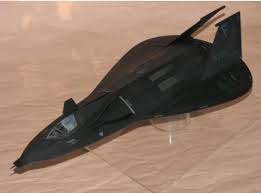 Such as this
Such as this It was the Soviets who were 'behind' and would have a hard-angle, blunt and block shaped aircraft like this:
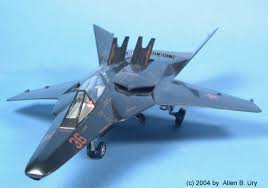
And admit it, both of them looked cooler than the F117 when it was finally revealed
Randy
Last edited:
- Joined
- 26 May 2006
- Messages
- 34,894
- Reaction score
- 15,759
So did they make a prototype? Did this Couzinet aircraft ever fly? I noticed the words "reportedly" and "It is claimed". But it also says "expected to be flown in April". Was it?
Models, RC prototypes and mock-ups but no flying examples and the numbers were all estimates as far as I can find.
Dar edwest,
Thanks for the major improvement in your attitude.
Now, do you have any photos or drawings of Couzinet's flying disc?
Thread here:
It was essentially a helicopter with the counter-rotating disks having a large number of blades (the 'vanes' mentioned) to achieve VTOL and a jet engine to provide forward thrust. Not sure how control and stability were maintained.
Dear edwest and RanulfC,
Most low-aspect ratio aircraft made sense given the knowledge of 2-dimensional airflow during the 1930s. Two-dimensional airflow failed to consider that massive wing-tip vortices developed at high angles of attack.
Actually some did such as Charles Zimmerman who, for one thing, suggested massive, 'slow' moving props to help channel and control the vortices as in the Flying Flapjack/Pancake.. Others looked toward circular/oval joined wings and various wing-tip vortice control devices
They also failed to consider that turbulent boundary airflow - at high angles of attack - rendered trailing edge control surfaces useless. Hence the Junkers flaps and ailerons on Nesmith Parasol.
Or move the control surfaces off or outboard the main structure such as the above examples and most parasol aircraft.
The Avrocar flying disc was funded by the US Army and hopelessly optimistic.
The Air Force paid for a version as well which is how they got the two prototypesAs I noted it lacked the propulsive power needed to accomplish what they wanted and duct drag for the exhaust was more than calculated which was not an unusual finding with ducted thrust aircraft testing of the time. Few of the engineers it seems actually trusted the main rotor to hold together under a full load and they had to build a full-size test rig (inside a substantial and rather expensive berm and containment system) and run it at full power to get agreement to install it in the prototypes.
And this was a compromise engine anyway with the thrust of the three turbojets engines was used for turning the "turborotator" which in and of itself was supposed to augment the jet engines thrust and provide vertical lift. The thrust was ducted to various periphery exhaust nozzles which provided stability and control. This was a downgrade from the original six engine version which kept catching fire and damaging itself during testing. The original engine design was arguably even more powerful but vastly harder to design and build even in theory.
The original engine designed by Frost was a horizontal "centrifugal" compressor that fed numerous combustion/exhaust cans at the periphery which would directly feed thrust out from there through rotating adjustable nozzles. Great in theory but didn't work so well in trying to build one, especially those nozzles and the required materials for the mechanisms and seals. Frost considered the Coandă effect a means of solving most of these problems along with moving flaps as part of the exhaust surface so as to achieve vertical lift. You still had material problems because this exhaust was flowing straight from the combustion chambers out onto and over the wing surface and then over the flap and hinge mechanism. This gave all around thrust that could be used to provide VTOL thrust and he assumed that it would be a rather straight forward problem to design some mechanism for turning the thrust yet again from flowing across and over the edge to flowing aft for forward thrust. Part of the exhaust of the 'forward-facing' (in level flight) engines would use be used to provide a modified Coandă effect that would provide a 'virtual' airfoil over the surface of the disk while the exhaust systems at the edge of the disk would provide a 'barrier' for the normal tip vortices that would form and all this would force most of the airflow to remain 'fixed' over the disk surface during subsonic flight and therefor having the disk airfoil section being optimized for supersonic flight only. As there would be no actual 'control surfaces' on the vehicle all control would be by directing the exhaust of the peripheral engines as need to achieve directional control and stabilization.
The key to all this was the periphery control system and the complex system of high temperature flaps and nozzles. Frost considered those "just" mechanical engineering problems and assumed they would be solved later. (They never were at the time and even today the highly vectored nozzles of modern aircraft are difficult and expensive to make and require a very sophisticated computer control to work) So Frost and Avro had to settle for a lower performance demonstrator system and eventually a far TOO low performance engine system.
As for re-loading the bazooka ... bazookas produce such a huge back-blast that they instantly attract all many of anti-bazooka fire from disgruntled enemy, ergo most bazooka gunners fire a single round, then duck behind a hill to reload and re-surface in a new firing position a few metres/yards off to the side. This is standard practice for most self-propelled anti-tank weapons.
And by such vehicles as the Attack helicopter which the concept was vaguely aimed forI was being more than a bit joking there as it would likely be a recoiless with a feed system which were being experimented on around that time but more in reference to such uses as the Marine Corps "Ontos" RR-carrier where you got six shots and then someone had to climb out and reload those six rifles
Avrocar may have been a dud, but it provided experience that re-exported to Britain where Saunders-Roe built the first practical hovercraft. The key British advance was adding skirts to contain lifting air.
Oh there was actually a TON of good data and work gained from the Avrocar's and not just hovercraft work either as I noted. Both the US Army and Air Force continued to use the prototype for several more years of extensive testing for things like control and augmented stability systems among other uses and they were not totally 'retired' until the early to mid 60. Calling them a 'failure' because they never reached the optimistic claims of the original designer for a far more advanced vehicle, while ignoring they were never meant to be more than initial prototypes in the first place is rather disingenuous.
Before saying anything more about Avrocar, I strongly suggest reading Bill Zuk's book about "Canada's Flying Saucer." It is well-researched and provides volumes of historical data.
Have to check it out I had apparently missed that one
As an aside, I suspect that first-generation stealth airplanes (e.g. F-117 Nighthawk) were triangular because that was the best engineers could calculate before modern massive computers. Stealth technology remains a "dark art" that Americans are reluctant to share with anyone else, for fear that they lose their military advantage.
As noted the triangle or highly swept delta form was found to be one of the more consistent stealth shapes that also had good aerodynamic qualities. What disappointed everyone was we'd been led to believe the US was so advanced with stealth that our's would be all smooth curves with no hard edges.
View attachment 640411 Such as this
It was the Soviets who were 'behind' and would have a hard-angle, blunt and block shaped aircraft like this:
View attachment 640412
And admit it, both of them looked cooler than the F117 when it was finally revealed
Randy
Randy,
You are a very good storyteller. You present scenarios designed only to fit your preconceived notions. Another design that was very similar to what Couzinet had was proposed by a German in the same time period. But posting further information here would not be advisable
Production version of the AS 7???
"Flying Saucer Technology" by Bill Rose, Midland, 2011.
- Joined
- 11 March 2006
- Messages
- 8,625
- Reaction score
- 3,804
Sorry, I'm struggling with my mobile, as the only connection to the world duringShould we have a separate thread for M. Cousinet's flying disc concepts?
our holidays, and it seems, as I'm losing the fight .. but the Couzinet thread
is here, I think :
Similar threads
-
-
-
-
-
Publication of "Flying Wings and Flying Saucers" delayed till the first half of 2021.
- Started by Justo Miranda
- Replies: 24

